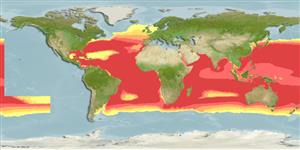Environment: milieu / climate zone / depth range / distribution range
Écologie
marin; océanodrome (Ref. 51243). Subtropical
Central Atlantic: Southwards to South Africa in the eastern part. Records outside central western Atlantic should be different species (H.Ho, pers.comm. 2/2017).
All reports in the Mediterranean Sea before 2017 are misidentifications for Bregmaceros nectabanus Whitley, 1941.
Taille / Poids / Âge
Maturity: Lm ? range ? - ? cm
Max length : 7.8 cm TL mâle / non sexé; (Ref. 40727); common length : 6.0 cm SL mâle / non sexé; (Ref. 47377)
Description synthétique
Clés d'identification | Morphologie | Morphométrie
Épines dorsales (Total) : 0; Rayons mous dorsaux (Total) : 48 - 57; Épines anales: 0; Rayons mous anaux: 49 - 60; Vertèbres: 49 - 57. The head is of moderate size; eyes large; snout rounded. The first dorsal fin is well separated from the second dorsal fin. The body is brownish above, silvery below.
Generally oceanic. Feed on zooplankton and phytoplankton, especially crustaceans (Ref. 6735). Oviparous, with planktonic eggs and larvae (Ref. 6735).
Life cycle and mating behavior
Maturité | Reproduction | Frai | Œufs | Fécondité | Larves
Cohen, D.M., 1990. Bregmacerotidae. p. 524-525. In J.C. Quero, J.C. Hureau, C. Karrer, A. Post and L. Saldanha (eds.) Check-list of the fishes of the eastern tropical Atlantic (CLOFETA). JNICT, Lisbon; SEI, Paris; and UNESCO, Paris. Vol. 2. (Ref. 4496)
Statut dans la liste rouge de l'IUCN (Ref. 130435: Version 2024-2)
Menace pour l'homme
Harmless
Utilisations par l'homme
Outils
Articles particuliers
Télécharger en XML
Sources Internet
Estimates based on models
Preferred temperature (Ref.
123201): 15.1 - 27.6, mean 22.4 °C (based on 1483 cells).
Phylogenetic diversity index (Ref.
82804): PD
50 = 0.5001 [Uniqueness, from 0.5 = low to 2.0 = high].
Bayesian length-weight: a=0.00380 (0.00219 - 0.00659), b=3.19 (3.03 - 3.35), in cm total length, based on LWR estimates for this species & (Sub)family-body (Ref.
93245).
Niveau trophique (Ref.
69278): 2.8 ±0.24 se; based on food items.
Fishing Vulnerability (Ref.
59153): Low vulnerability (10 of 100).
